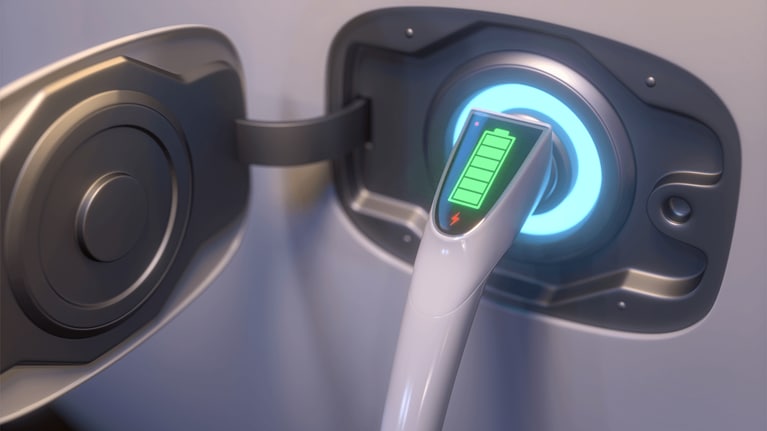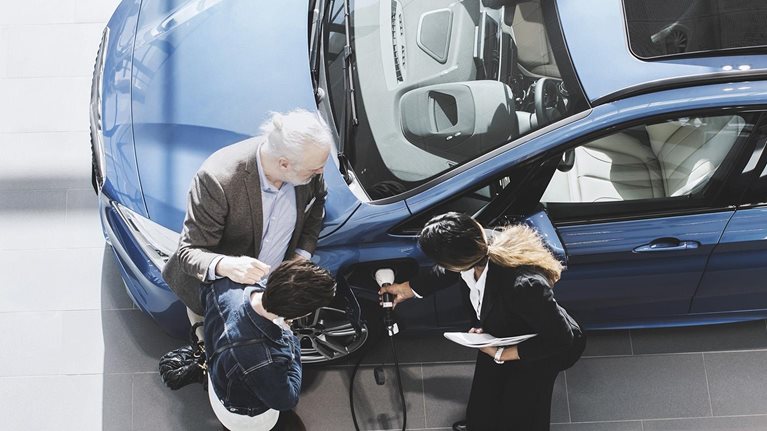Electric vehicles (EVs) are ramping up production, picking up market share, and capturing mindshare among drivers and policy makers alike. So far, almost all EVs have relied on wired charging solutions in which drivers plug in a cable to recharge the car’s battery. But wireless or automated charging holds vast potential to make EV ownership more convenient, cost-effective, and appealing for drivers and fleet operators.
There are multiple technologies that promise to free drivers from the inconvenience of manually plugging their EVs into an electricity source using a physical cable. To get a sense of how EV drivers might be able to break free from their cords, McKinsey’s Florian Nägele and Shivika Sahdev spoke recently with InductEV chief commercial officer Bob Kacergis and the company’s former chief innovation officer Andrew Daga. InductEV provides inductive wireless solutions. They were joined by Alex Gruzen, CEO of inductive wireless charging company WiTricity, and Gregor Eckhard, COO of automated conductive charging system provider Easelink. The transcript has been edited for clarity and length.
McKinsey: The first thing we’d love to know is how wireless charging compares with wired charging on efficiency.
Andrew Daga: A wireless inductive charging system is at least one or two percentage points more efficient than a DC [direct current] fast charger at the same power level. People think energy is lost in the gap between the charger and the vehicle, but we operate in a near-field system using highly coupled inductors that do not radiate into free space.
Alex Gruzen: Wireless charging can be just as efficient as plugging an EV into a charger. The vehicle can charge just as quickly and at the same rate as if it were plugged in.
McKinsey: How about charging speeds? Is wireless charging faster or slower than EV charging delivered through a cable?
Bob Kacergis: Charging speed is determined by a vehicle’s battery management system, so any system should charge batteries at the same rate. But from an operations standpoint, wireless systems can perform alignment, authentication, verification, and initiate charging within a few seconds of the vehicle arriving at the charger, which means wireless charging can add range during even a two-minute stop. Wired systems don’t provide short-duration charging opportunities because drivers have to get out of the vehicle, find the plug, attach it to the car, unplug it, and get back in the car to drive off.
McKinsey: Is wireless charging as safe as wired?
Alex Gruzen: Wireless EV charging is perfectly safe. In fact, it’s akin to the inductive cooktop technology that has become popular in kitchen renovations around the world. There are rules about magnetic fields, and we operate within those without exception.
Andrew Daga: From a safety standpoint, we have developed our system with four charging pads that give less of an EMF [electromagnetic field] signature than a single pad, because the multiple pads use software to operate in a way that self-cancels the stray magnetic field. But all of our systems, whether they use one or multiple pads, are consistent with ICNIRP [International Commission on Non-Ionizing Radiation Protection] guidelines.
McKinsey: What is conductive automated charging?
Gregor Eckhard: Conductive charging relies on a physical connection, which optimizes efficiency. A manual plug is conductive, but conductive charging can also be automated, as with our technology. The most convenient way to do this is to build the conductive charging system into the underbody of the vehicle. Drivers can think of conductive automated charging as functioning like an invisible plug that combines the best of both worlds. Our conductive system is one-third to one-half the cost of an inductive charging alternative. The lower costs of conductive technology make it feasible for drivers outside the high-luxury segment to enjoy the benefits of automated EV charging.
McKinsey: What kinds of personal vehicles will be the first to use wireless or automated charging?
Alex Gruzen: Because we’re in the early stages of the adoption curve from volume, scale, and cost perspectives, wireless charging will appear first in premium vehicles. But I think it will quickly work its way into more mainstream vehicles.
Gregor Eckhard: In the home-charging market, we see automated charging appealing to early tech adopters buying premium vehicles. We also see specific use cases where commercial vehicles such as electric taxis will definitely benefit from automated charging. For example, by 2025, Vienna, Austria, will allow only electrified taxis. But taxi drivers said they could not be profitable if they had to spend an hour each shift at a charging station. So, city planners had to figure out the most efficient way to let them charge at the taxi stand, without cables and charging poles getting in the way or making drivers plug and unplug their vehicles each time they advance to the next place in line. An automated charging solution with the technology integrated into the underbody of the vehicle solves their problem.
McKinsey: Where could wireless charging add value in commercial environments?
Alex Gruzen: One example of the value of wireless charging in the commercial space is that it allows trucks to recharge while they are loading or unloading. Going wireless in this context eliminates the risk of people tripping on cables or running over connectors. Also, when vehicles have more opportunities to charge using wireless technology, you can spread the charging load out over time, reduce peak load, and reduce the need to build new substations. We did a study for a global logistics company that showed our wireless charging solution could reduce their total energy costs by up to 50 percent.
Bob Kacergis: Wireless charging makes a lot of sense for high-value, high-use vehicles like buses and short-haul and regional trucks that are very expensive to take offline while they charge. Our primary traction is in fleet vehicles, particularly on the heavy-duty end. We’re also doing a lot of work with fire trucks and ambulances in Europe and North America. The value proposition is around having vehicles that are always ready to deploy at a moment’s notice without the risk that might occur with people getting tangled in power cords in an emergency environment.
McKinsey: What is the cost of moving to wireless or automated charging today, including equipment and installation?
Alex Gruzen: It’s not radically different from that of a Level 2 charger. Up to three-quarters of wireless systems’ cost is on or in the ground; the part on the vehicle is the lowest-cost piece. For the operator, our calculations show a reduction of up to 50 percent in the total cost of ownership using wireless chargers versus traditional cables. With wireless technology, there is less maintenance, less potential for vandalism, and less wear and tear because cables and connectors aren’t being plugged in and unplugged several times a day.
Gregor Eckhard: With our conductive system, the cost on the infrastructure side is comparable to a premium wall box. From a charge-point operator perspective, our system has lower maintenance costs and requires less space because the charging pad is integrated into the floor of the parking space, so no poles are needed to hold a charger. The on-vehicle costs are much smaller than the infrastructure costs.
McKinsey: What are the main barriers to broader acceptance of wireless charging?
Andrew Daga: Wireless charging systems are still too expensive for typical passenger vehicles. We see a way to make it affordable, but it depends on reaching higher production volumes. So, our entry into the market will be in luxury vehicles, where customers are less sensitive to the incremental cost.
In addition, many automakers still believe that wireless charging is not capable of achieving high power and therefore is only suitable for home garages. But we know that wireless chargers can deliver high power in public locations such as supermarket parking lots, where they can add 100 miles of range while customers shop for a half-hour. It just happens in the background, like with electronic toll collection. This is how we see the evolution of wireless charging—but we still have to convince the OEMs.
Bob Kacergis: Our commercial approach right now revolves around market development through education. We’ve created what I call “EV tourism” at our customer sites. I am constantly taking people to Indianapolis, Martha’s Vineyard, Oslo, or Gothenburg to see our charging systems in action. You would think that it’s unexciting to watch a car charging, but when people sit in the car and experience wireless charging for themselves, it’s a magical moment for them. Every time we install a demo system somewhere, it helps us sell more chargers.
McKinsey: When do you believe we’ll start seeing many OEMs roll out wireless or automated charging capabilities in new vehicles?
Alex Gruzen: Most of our effort over the past decade has been working directly with OEMs to get wireless charging designed into vehicles and to align the industry around wireless charging standards. Now we’re starting to see vehicles with wireless charging technology built in. This year, we’ve seen two vehicle launches in China and one in South Korea, and German, American, and Japanese OEMs are planning launches over the next few years. I think we will see many OEMs deploy wireless charging technology by 2024 or 2025.
Gregor Eckhard: We expect to launch our first OEM product in 2026. Until then, we are pushing forward with a business case of retrofitting commercial vehicles like taxis, as well as a product tailored for use in private homes. In the end, OEMs that see themselves as technology and innovation leaders will play the decisive roles in determining which charging technology succeeds on a broad scale.
McKinsey: How could wireless or automated charging reinforce the advantages of other advanced automotive technologies?
Alex Gruzen: It complements other features automakers want to offer, such as autonomous parking. In fact, EV OEMs and real estate developers are already partnering in China to integrate wireless charging with autonomous parking garages, so that EVs equipped with wireless technology can park and charge themselves. Then drivers can summon the recharged cars when they want to drive them again. When autonomous parking and autonomous driving enters the mix, wireless charging shifts from being a value-added feature to a necessity.
Gregor Eckhard: Automated charging could reinforce the integration of vehicles into the electricity grid. Most drivers plug in their cars when the batteries are empty, but in order for a smart grid to work, vehicles need to be connected to it all the time, especially when the batteries are fully charged. Automated charging therefore will play a crucial role at the intersection of two major industries—automotive and electric utilities.
McKinsey: What would you say to people who argue that consumers don’t really care how their cars charge?
Alex Gruzen: I have spent 20 years working in consumer products, and I’ve seen people getting rid of cords in everything from computers to telephones. Now we’re on the cusp of one of the biggest technological transitions in mobility, and we’re trying to stick a charging cord back into people’s lives—are you kidding me?
The market speaks, and everything I’ve ever seen go wireless has stayed that way. Wireless charging delivers a fantastic ownership experience. We’ve done market research showing that when you introduce consumers to the idea, their interest in getting an EV jumps by 68 percent. This is a feature that will make people want to buy EVs.
Gregor Eckhard: When we speak to EV drivers, they are immediately amazed by the idea of automating the charging process and eliminating the inconvenience of plugging in their vehicles. I am fully convinced that once consumers experience automated charging firsthand, there will be no going back.
Andrew Daga: Wireless charging is really fully automated DC fast charging. It is this automation that translates into greatly reduced costs of charging and offers an unmatched value proposition, especially for fleets.
When I started the company over 12 years ago, wireless charging was seen as magic or a violation of the laws of physics. Then people admitted it worked but were skeptical that anyone really needed it. Now we’re at a stage where people are using it and saying, “We have to have this.”


